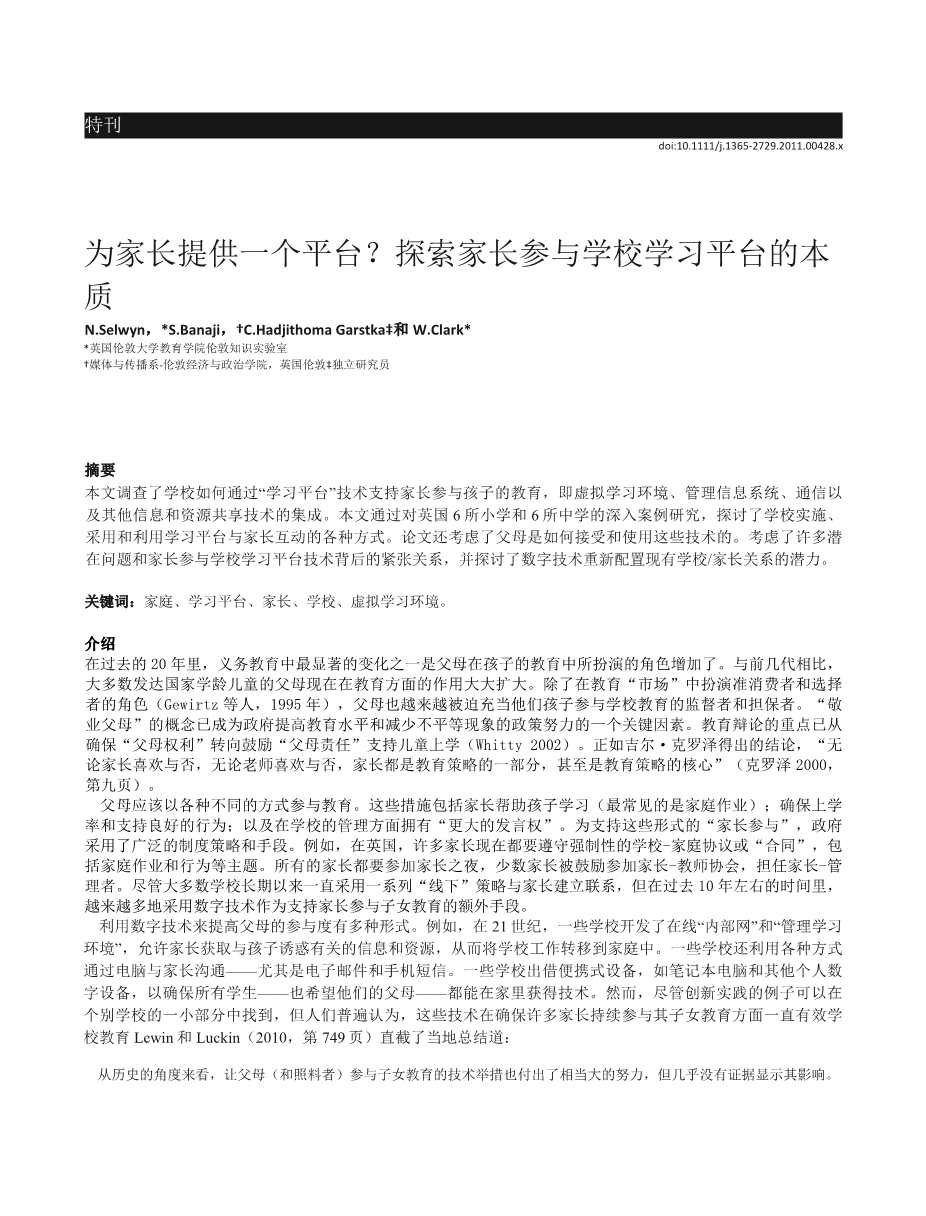Special issue
doi: 10.1111/j.1365-2729.2011.00428.x
Providing a platform for parents? Exploring the nature of parental engagement with school Learning Platforms
N. Selwyn,* S. Banaji,dagger; C. Hadjithoma-GarstkaDagger; amp; W. Clark*
*London Knowledge Lab, Institute of Education – University of London, London, UK
dagger;Department of Media and Communications – London School of Economics and Political Science, London, UK
Dagger;Independent researcher
Abstract This paper investigates how schools are supporting parentsrsquo; involvement with their childrenrsquo;s education through the use of lsquo;Learning Platformrsquo; technologies – i.e. the integrated use of virtual learning environments, management information systems, communications, and other infor- mation and resource-sharing technologies. Based on in-depth case studies of six primary and six secondary schools across England, the paper explores the various ways that schools are implementing, adopting, and using Learning Platforms to engage with parents. The paper also considers how these technologies are being received and used by parents. A number of under- lying issues and tensions behind parentsrsquo; engagement with school Learning Platform technolo- gies are considered, and the potential of digital technologies to reconfigure pre-existing school/ parent relationships is examined.
Keywords home, learning platform, parents, schools, virtual learning environment.
Introduction
One of the most notable shifts in compulsory education over the last 20 years is the increased part that parents are expected to play in their childrenrsquo;s schooling. Parents of school-aged children in most developed countries now have a considerably expanded educa- tional role when compared with that of previous genera- tions. As well as acting as quasi-consumers and choosers in educational lsquo;marketplacesrsquo; (Gewirtz et al. 1995), parents are increasingly compelled to act as monitors and guarantors of their childrenrsquo;s engagement with schooling. The notion of the lsquo;engaged parentrsquo; has become a key element of governmental policy efforts to improve educational standards and reduce inequalities. The emphasis of educational debate has shifted from
Accepted: 16 May 2011
Correspondence: Neil Selwyn, London Knowledge Lab, 23-29 Emerald Street, London WC1N 3QS, UK. Email: n.selwyn@ioe.ac.uk
ensuring lsquo;parental rightsrsquo; to encouraging lsquo;parental responsibilitiesrsquo; in supporting childrenrsquo;s schooling (Whitty 2002). As Gill Crozier concludes, lsquo;whether parents like it or not and whether teachers like it or not, parents are part of, even central to, the education strat- egyrsquo; (Crozier 2000, p. ix).
Parents are expected to be educationally involved in a number of different ways. These include parents assist- ing children in their learning (most commonly with homework); ensuring school attendance and supporting good behaviour; and having a lsquo;greater sayrsquo; in how schools are run. A wide range of institutional strategies and devices has been employed to support these forms of lsquo;parental involvementrsquo;. In the UK, for example, many parents are now subject to mandatory school– home agreements or lsquo;contractsrsquo; that cover topics such as homework and behaviour. All parents are expected to attend parentsrsquo; evenings and, for a few, encouraged to participate in parent–teacher associations and act as
314 copy; 2011 Blackwell Publishing Ltd Journal of Computer Assisted Learning (2011), 27, 314–323
parent–governors. Whereas most schools have long uti- lized a range of lsquo;offlinersquo; strategies to connect with parents, digital technologies have been increasingly deployed over the last 10 years or so as an additional means of supporting the engagement of parents in their childrenrsquo;s schooling.
The use of digital technology to increase parental engagement has taken a number of forms. During the 2000s, for example, some schools developed online lsquo;intranetsrsquo; and lsquo;managed learning environmentsrsquo; to allow parents to access information and resources relat- ing to their childrsquo;s education, thereby easing the transfer of school work into the home. Some schools also made use of various modes of computer-mediated communi- cation with parents – not least email and mobile phone- based text messaging. Some schools loaned portable devices such as laptop computers and other personal digital devices to ensure that all students – and it was hoped by extension their parents – have access to tech- nology at home. Yet while instances of innovative practice could be identified in a small percentage of individual schools, it is generally accepted that these technologies have up until recently proved ineffective in ensuring the sustained involvement of many parents in their childrenrsquo;s schooling. As Lewin and Luckin (2010,
p. 749) concluded bluntly:
a historical perspective on the technology initiatives to engage parents (and carers) in their childrenrsquo;s education reveals a considerable amount of effort but little evidence of impact.
This previous lack of impact notwithstanding, as the 2010s progress growing efforts are being made both from within schools and from national and regional policymakers to encourage the coordinated and system- atic use of digital technologies to support parent–school engagement. In particular, schools around the world are now being encouraged to develop and maintain inte- grated schoolwide lsquo;Learning Platformsrsquo; to enable all members of the school community to access learning resources, communicate and collaborate with each other, as well as monitor, assess, and report on student progress. For example, primary and secondary schools in the UK were given financial and technical supports from central and local governments throughout the latter half of the 2000s to develop Learning Platforms. Simil
剩余内容已隐藏,支付完成后下载完整资料


英语译文共 8 页,剩余内容已隐藏,支付完成后下载完整资料
资料编号:[604992],资料为PDF文档或Word文档,PDF文档可免费转换为Word


